If you own a lawn, you must know that you are always trying to improve soil quality and make your grass greener. A lawn with a deep green color is not only healthy, but it also looks aesthetically very pleasing. However, if you want green grass and a healthy lawn, you will have to work all year round and implement a proper lawn care plan. In this article, let’s talk about ironite vs milorganite.
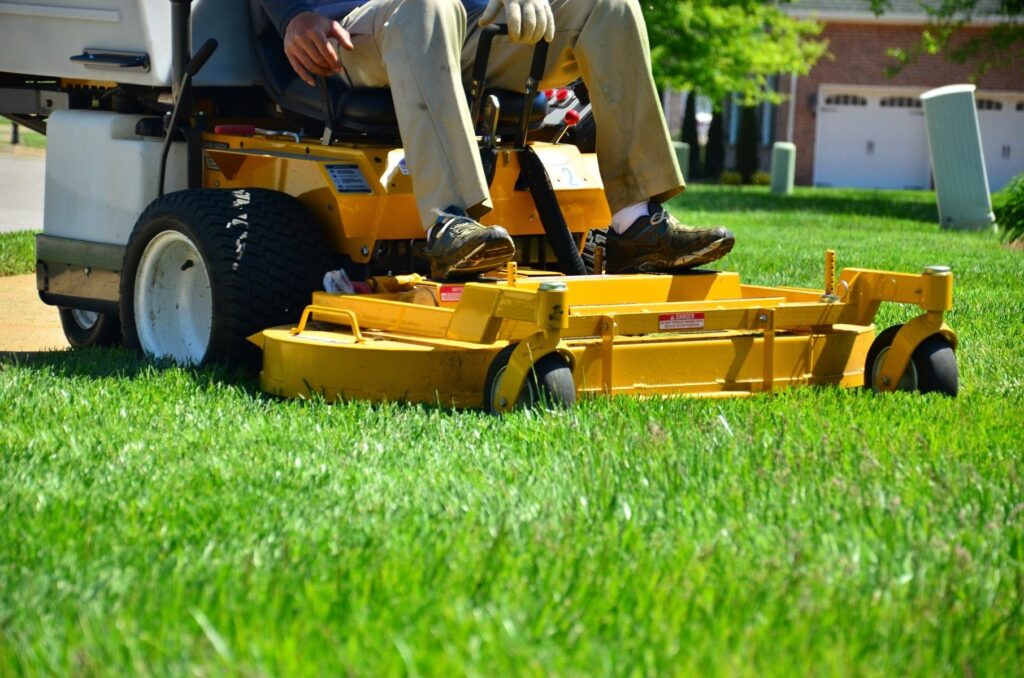
Photo Credit We highly recommend taking a soil test before using Milorganite or Ironite in your yard.
In addition to a proper lawn care plan, healthy soil is a must and you will have to use a lawn supplement from time to time to deal with issues such as iron deficiency and slow grass growth. Ironite and Milorganite are two such lawn products that contain iron and a number of other nutrients to help you green your lawn and ensure healthy grass growth.
While both Ironite and Milorganite contain almost every nutrient a lawn requires, they work in different ways and serve slightly different purposes. Therefore, one might be better than the other in certain situations, depending on the lawn condition. This article will provide you with a brief comparison of Ironite and Milorganite and help you decide which lawn supplement is best for your lawn.
Milorganite Vs. Ironite
Both Ironite and Milorganite are used extensively in lawns throughout the United States for promoting rapid growth and improved soil quality. Both contain iron, nitrogen and a range of other micronutrients that will help you keep your lawn green and your grass healthy.
However, there are some differences between Milorganite and Ironite in terms of their composition and action. To help you understand these differences, we will start with a general overview of both supplements and then present you with a table containing the significant differences between Ironite vs. Milorganite. Let’s start!
Milorganite
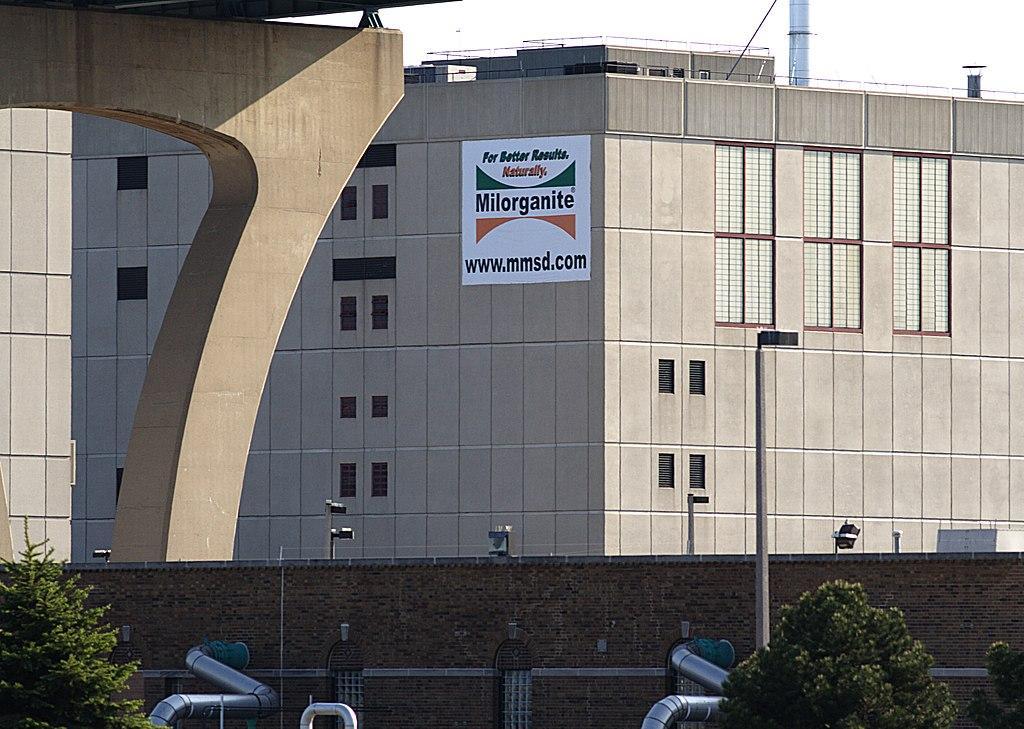
Photo Credit Milwaukee metropolitan sewerage district: Factory where organic fertilizer Milorganite is made.
Milorganite is an organic lawn fertilizer that is manufactured by Milwaukee Metropolitan Sewerage District. It is a slow-release fertilizer that is prepared using eco-friendly microbes. The microbes absorb nutrients from wastewater which are then put together with compost and other recycled materials to create Milorganite.
While the fact that Milorganite is developed using wastewater might put a lot of people off, there is no need to worry. The wastewater and all the recycled materials are thoroughly treated and are entirely safe to use on your lawns. In other words, Milorganite is simply a natural fertilizer to help you keep your lawn healthy and your grass green.
Milorganite contains all the essential nutrients that create the foundation of a healthy lawn. It contains potassium to strengthen the roots, nitrogen to speed up the growth, and iron to help you maintain a green lawn. All in all, Milorganite is a nitrogen fertilizer that you can apply directly to your lawn grass to ensure thicker, fuller and greener lawns.
Ironite
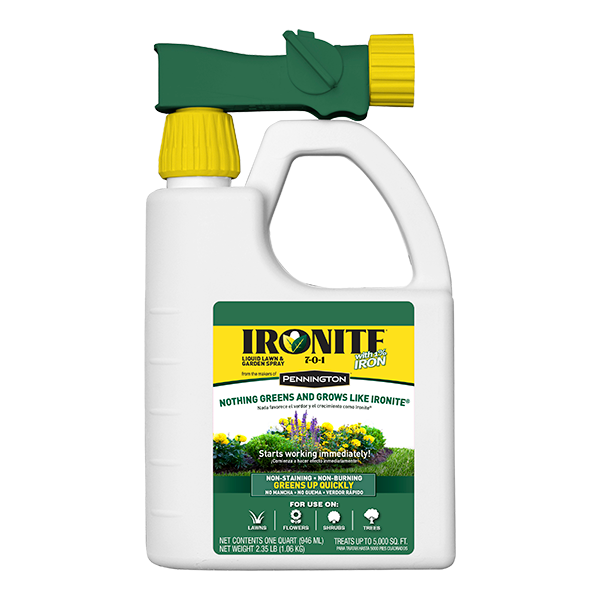
Photo Credit Liquid Ironite spray that makes applying Ironite to lawns easier.
Ironite is manufactured by Pennington Seed Incorporated. They make a range of lawn products, including the Ironite fertilizer. Ironite is used by homeowners and professionals alike to establish and maintain green grass and treat iron deficiencies in the lawn. However, unlike Milorganite, a full-fledged organic lawn fertilizer, Ironite is only a synthetic nutrient lawn supplement that is primarily used in case of an iron deficiency.
Mostly, it is used to re-green the lawn when grass blades turn yellow. Yellowing grass blades are a telltale sign of yellowing leaves. However, in addition to iron, Ironite also contains numerous other nutrients and when applied, it promotes the development of deep green color. Results are often apparent within a few days; however, you will have to wait a few weeks to see any significant difference in your lawn.
Ironite comes in both liquid form and granular form. Depending on your needs, you can choose between any of them. However, be careful while spraying liquid Ironite on your lawn as it is known to stain concrete, paving slabs, and wood.
Milorganite vs. Ironite Comparison
Now that you know a little bit about both of these iron supplements. Let’s go ahead and compare Milorganite with Ironite and look at the few key difference between Milorganite vs. Ironite:
| Milorganite | Ironite |
| Milorganite is a full-fledged fertilizer | Ironite is a lawn, specifically an iron supplement |
| It contains around 2.5 percent around | It contains nearly 20 percent iron |
| Used as a fertilizer to improve soil quality | Used when the grass turns yellow |
| Based on a slow-release method | Based on a fast-acting formula |
| It will be a few weeks before you notice an improvement | You will see results in a few days |
| Can be applied in excess with minor to no damage to the lawn | If used in excess, it can cause severe lawn burns, especially during hot weather |
| It makes grass grow fuller and thicker | It makes grass green without excessive growth |
| It contains heat-dried microbes and other organic materials | It does not contain microbes or organic materials |
| A more eco-friendly and sustainable lawn solution | Less eco-friendly |
| Provides lawn with soluble nitrogen | Provides lawn with soluble iron |
RELATED: Planting, Mowing And Watering Bermuda Grass Lawn | How To Do It Right?
Milorganite or Ironite: Which Nutrient Supplement To Use?
As evident by the data presented above, both Milorganite and Ironite are excellent lawn care products; however, they serve different purposes. Depending on your requirements, you will have to choose between them. To help you with your choice, here are some of the common lawn scenarios in which one might do better than the other:
Nutrient Poor Soil
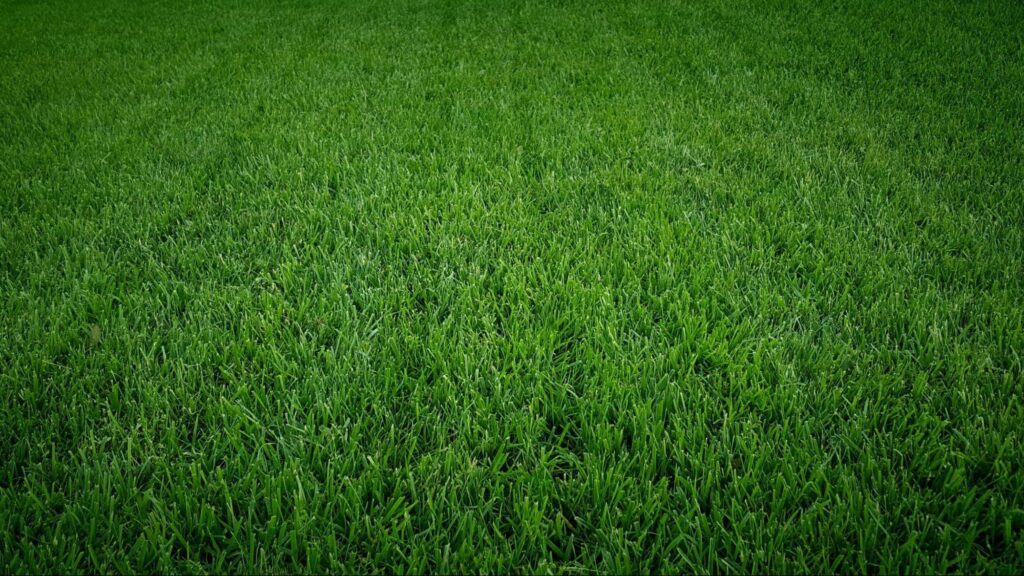
Photo Credit Use Ironite if your soil is severely iron deficient.
If there is a shortage of essential nutrients in your lawn, the grass will not be able to grow to its full potential. It will result in the formation of a patchy turf that looks aesthetically displeasing and is also prone to weed infestations. Nutrient requirements will be different depending on the lawn soil, so we highly recommend that you test the soil of your lawn before choosing between Ironite or Milorganite.
Once you have the results, you can go with Milorganite if your lawn is lacking in a lot of nutrients. It is because Milorganite contains a healthy mix of numerous nutrients such as nitrogen, phosphorus, potassium, sulfur, magnesium, and calcium. In addition to that, it also has recycled and compost materials which will increase the organic content of your lawn, promoting thicker, fuller and healthy grass growth.
However, if the test results show severe iron deficiencies, you should go with Ironite. Even though Ironite also contains numerous essential nutrients, most of it is soluble iron. And because of its fast-acting formula, iron becomes readily available to the soil. Also, it does not promote extra grass growth, which is suitable for such situations when the lawn is thick and full but has turned yellow.
Yellowing Grass
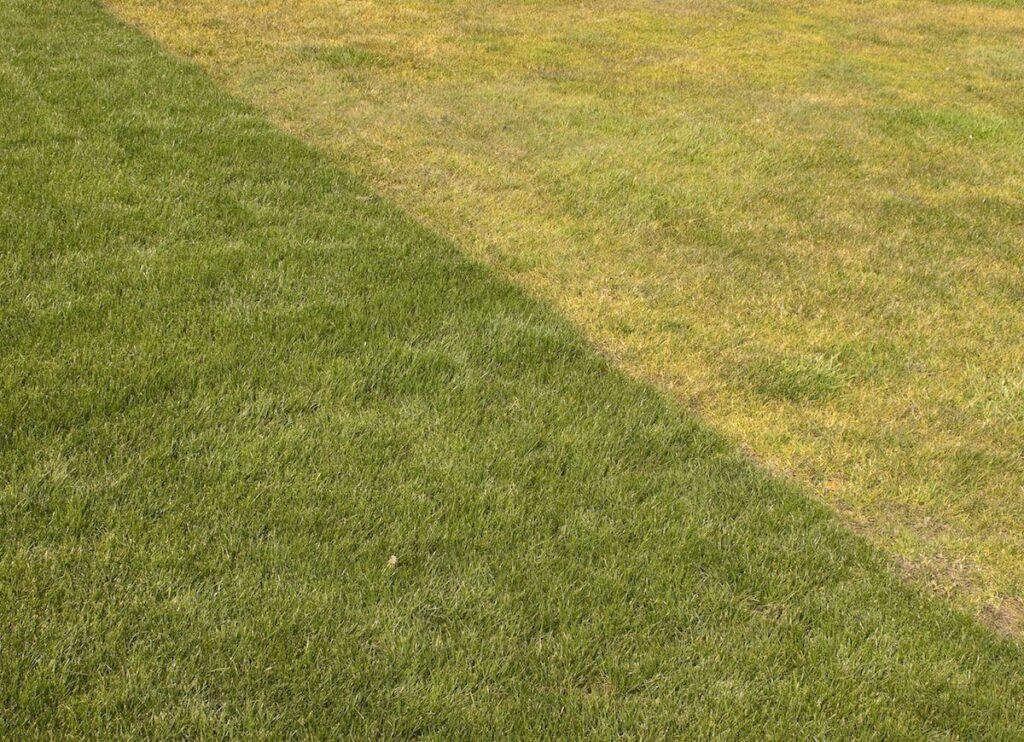
Photo Credit Apply Ironite to turn your grass green quickly.
Another common situation that many lawn owners have to deal with is the yellowing of grass. There could be many reasons behind yellowing grass in your yard; however, it is the deficiency of iron in many cases. Iron deficiencies are often mistaken for nitrogen deficiencies as both cause the yellowing of the grass blades.
However, depending on the location of the leaf where the yellow color appears, you can differentiate between the two. If the yellowing is caused by reduced nitrogen availability, lower leaves start to turn yellow. This is the exact opposite of what happens in the case of the deficiency of iron.
Differentiating between the two situations is important because applying nitrogen to iron-deficient soil can worsen the matter. Adding extra nitrogen to soil increases grass growth which is a bad thing because the grass plants are already lacking enough iron. As a result, they will grow weaker and will be more prone to diseases.
All in all, adding an iron supplement is the best way to turn your grass green quickly. Both Milorganite and Ironite can be used on warm-season grasses such as Bermuda grass and Centipede grass, as well as Perennial ryegrass which is a type of cool-season grass.
RELATED: Top 10 Super Easy And Effective Ways Of Fixing A Muddy Yard
Poor Soil Quality
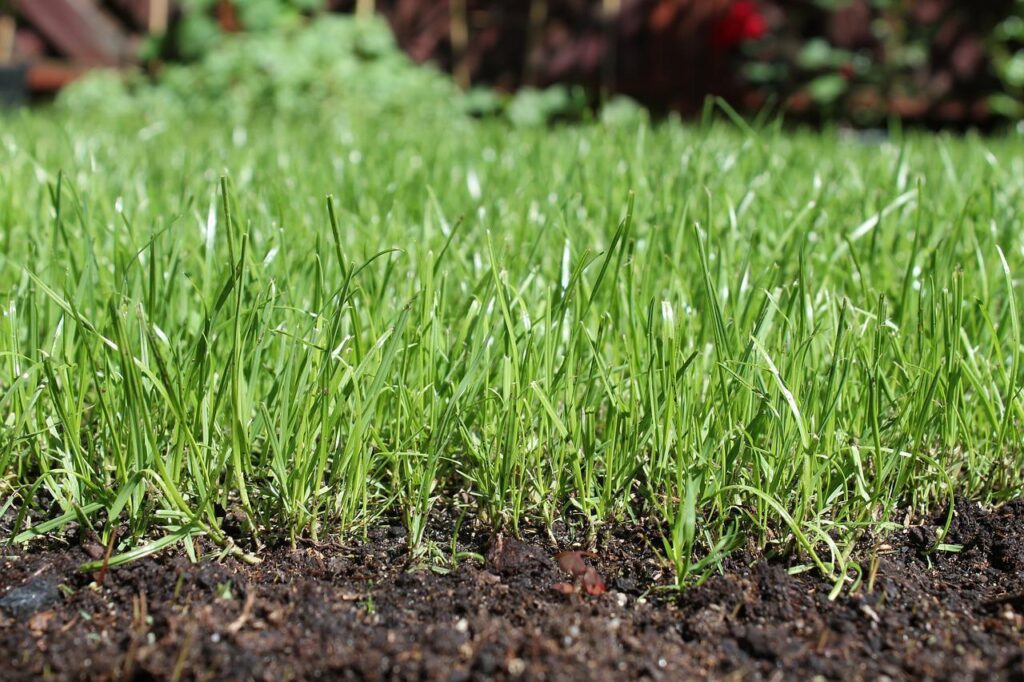
Photo Credit Use Milorganite if you want to improve the organic makeup of your soil.
Another reason you might consider using Ironite or Milorganite in your yard is to improve the quality of your soil. It should be obvious by now that Milorganite is a better choice in such a scenario. It is because it contains a mixture of compost and other organic recycled materials that improve lawn health and the quality of the soil.
Whereas, Ironite contains many harsh chemicals that can degrade and ruin the quality of the soil over long periods of time. The slow-release approach of Milorganite also makes it more sustainable and eco-friendly. In contrast, the quick release approach of Ironite is best suited for people who want immediate results in a matter of days.
Milorganite increases the organic content of the lawn soil and releases its nutrients slowly, increasing the resilience of both the soil and the turf. Also, Milorganite is a full-fledged fertilizer that can be used more often in yards than Ironite, whose quick action and chemical nature limits its frequent use.
Using Milorganite vs. Ironite
Now that we know a little bit about both supplements, let’s go ahead and look at how you can use them in your yard and what is the best time to use them.
When to use Ironite on the lawn?
Ironite is used when soil is running low on iron. You can check whether or not your soil is deficient in iron by getting the soil tested. You can simply apply Ironite to your grass when applying fertilizer. We suggest that you apply Ironite four to ten times to your grass in a year. In general, you should use maximum Ironite in your yard during the spring. It is the peak growing season for most grasses, and they need a lot of nutrients to grow healthy.
How do I apply Ironite to my lawn?
Ironite is available in both liquid and granular forms; the liquid Ironite can be directly sprayed on the grass; however, make sure not to use too much. Too much iron at once can turn the grass black. If you are using granular Ironite, make sure that you wear all the necessary protective gear to avoid chemical burns. Then, apply nearly a pound of Ironite per hundred square feet of lawn. Following that, use water on the grass and let it be absorbed. Also, ensure that you do not allow the children and pets onto the yard as Ironite is harmful if ingested.
When to use Milorganite on the lawn?
Since it is nitrogen fertilizer, you can use Milorganite as part of your yearly lawn care program. Depending on the grass you have in your yard, the best timing varies slightly. You should apply Milorganite to the grass late in the year for cool-season grass. However, we suggest using Milorganite in your yard in the late spring for warm-season grasses.
How do I apply Milorganite to my lawn?
Start by watering the lawn two or three days before you intend to apply Milorganite to the grass. Then, pour Milorganite into a spreader and spread it evenly throughout your yard.
Frequently Asked Questions
Which is better, Milorganite vs. Ironite?
If you want to both feed and green your grass, Milorganite is the better option because of its superior organic and chemical composition. However, if you want to turn your grass quickly green, nothing can compete with the Ironite.
Does Milorganite kill weeds?
Milorganite or Ironite on their own and alone can not kill weeds. However, you can crowd out most weeds by ensuring a proper lawn care plan and using Milorganite to increase the thickness and growth of the grass.
Is Milorganite high in iron?
In short, yes! However, compared to Ironite, the concentration of iron in Milorganite is nothing. Therefore, most people use Ironite to treat iron deficiencies quickly in their yards.
Sources for Further Reading
- Nutrient Deficiencies. Agriculture and Natural Resources, University of California. (2022). Retrieved 9 May 2022, from http://ipm.ucanr.edu/TOOLS/TURF/PESTS/abionut.html#:~:text=Iron%20deficiency%20is%20common%20in,creating%20dark%20areas%20in%20turf.
- Turf – Nitrogen and Iron Deficiencies. The University of Arizona, College of Agriculture and Life Sciences. (2022). Retrieved 9 May 2022, from https://acis.cals.arizona.edu/community-ipm/turfgrass/nitrogen-and-iron-deficiencies
- Iron Chlorosis in Turfgrass. Texas A&M University. (2022). Retrieved 9 May 2022, from https://aggie-horticulture.tamu.edu/plantanswers/turf/iron.html
Ironite Vs Milorganite, which one do you prefer? Make sure to check out our other articles:
Is Sand Good For Lawns? (and What Type of Sand for Lawns Is Best)







